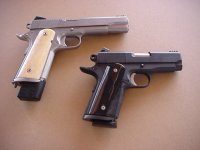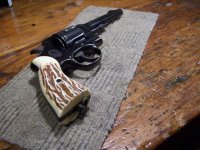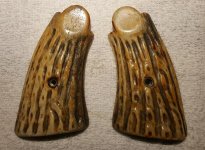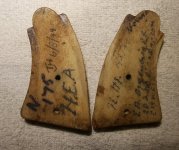Rick Bowles
Absent Comrade
Most of the early jigged bone was made by the Rogers Manufacturing Company of Rockfall, Connecticut. Rogers started making manufactured bone products, and bone fertilizer in 1891. They began to make jigged bone handles for knives and guns around the turn of the century. Other manufactured bone products included combs, toothbrush handles, baby pacifiers, and one of their biggest sellers, corn-cob pipe bits. By the time of the first World War Rogers Mfg. Co. was the nation's largest maker of manufactured bone products. At first, all of the bone used by Rogers Mfg. Co. came from domestic cattle. By the 1920s, or perhaps even earlier, all of the raw bone was coming from overseas, mainly from Argentina. Rogers Mfg. Co. also made jigged bone for hunting knives, gun stocks and kitchen utensils. This unique style of jigging was called "Indian Trail", a long, random "worm" style of jigging. During the Second World War, Rogers's production of jigged bone handles continued without interruption. Many of those handles wound up on cutlery items made for the government. The bone used by Rogers during the war was all imported from Argentina, Brazil, and a new source: Australia. The Australian bone came mainly from old tough range cattle, and was very thick, dense and strong. This heavy Australian bone quickly became the preferred material for handles. Though these distinctive stocks are no longer made commercially, hand made "Indian Trail" jigged bone stocks are still available.








